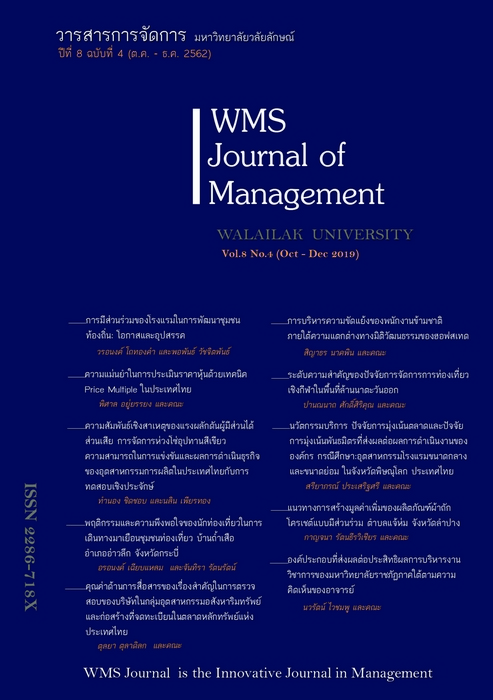Valuation Accuracy Using Price Multiple in Thailand
Main Article Content
Abstract
Stock price multiple, measured by multiplying “the ratio of stock price to a value driver” by a value driver (e.g. earning, sales, book value of the company), is a well-known equity valuation technique used in finance field. However, the studies on the application of stock price multiple technique in Thailand is still limited. Therefore, the present study is conducted to serve two major objectives. The first objective is to apply price multiple valuation method to examine the value of various firms listed in the Stock Exchange of Thailand. The second objective is to compare valuation accuracy of different value drivers of price multiple (i.e. EPS, BV, and EBITDA) in order to identify the most accuracy value drivers of price multiple technique. Data on EPS, BV and EBITDA are collected from 580 companies listed in the stock exchange of Thailand from January 2001 to December 2018. Data are classified into eight industrial groups and twenty-eight sectors. The test procedure starts with the selection of comparable firms within the same industry to calculate the price multiple ratio of comparable firms. The price multiple ratio of comparable firms is then multiplied by target firm’s corresponding value driver to calculate the estimated equity value. Finally, the estimated equity value is then compared with the equity price to see valuation errors. Results indicated that the accuracy of price multiple valuations differs for companies in different sectors in the Stock Exchange of Thailand. EBITDA provides the highest valuation accuracy among three value drivers for 14 out of 28 industrial sectors.
Article Details
References
Baker, M., & Ruback, R. (1999). Estimating Industry Multiples. MA: Harvard Cambridge.
Beatty, R., Riffe, S., & Thompson, R. (1999). The method of comparable and tax court valuation of private firms: an empirical investigation. Ac-counting Horizon, 13(3), 177-99.
Bhojraj, S., & Lee, C. (2002). Who is my peer? A valuation-based approach to the selection of comparable firms. Journal of Accounting Re-search, 40(2), 407-39.
Boatsman, J., & Baskin, E. (1981). Asset Valuation with Incomplete Markets. The Accounting Review, 56(1), 38-53.
Cheng, C. A., & McNamara, R. (2000). The Valuation Accuracy of the Price-Earnings and Price-Book Benchmark Valuation Methods. Re-view of Quantitative Finance and Account-ing,15(4), 349-370.
Damodaran, A. (2007). Valuation Approaches and Metrics: A Survey of Theory and Evidence. NY: New York University.
Kaplan, S., & Ruback, R. (1995). The valuation of cash flow forecasts: an empirical analysis. The Journal of Finance, 50(4), 1059-1094.
Kim, M., & Ritter, J. (1999). Valuing IPOs. Journal of Financial Economics, 53(3), 409-37.
Liu, J., Nissim, D., & Thomas, J. (2002). Equity valuation using multiples. Journal of Accounting Research, 40(1), 135-172.
Nel, W. S. (2009). Methods of choice in the valuation of ordinary shareholders’ equity: evi-dence from theory and practice. Meditari Ac-countancy Research, 17(2), 117-135.
Sayed, S. A. (2016). Does sophisticated DCF outperform heuristics driven PE? Evidence from India. Journal of Advances in Management Research, 13(1), 42-58.
Yoo, Y. K. (2006). The valuation accuracy of equity valuation using a combination of multi-ples. Review of Accounting and Finance, 5(2), 108-123.


